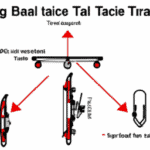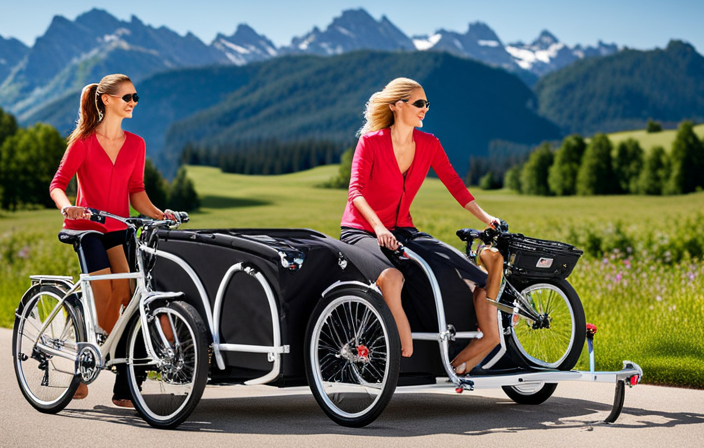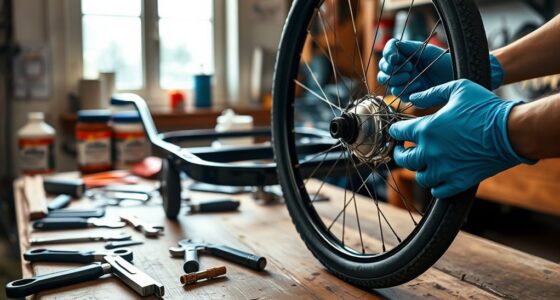I have always been surprised by the high number of bike accidents that occur due to mud and debris flying off the wheels. This is why I took it upon myself to create fenders for my bike trailer.
In this article, I’ll guide you through the process of making fenders that will keep you and your trailer safe and clean. We’ll gather the necessary materials, measure and mark the fender dimensions, cut and shape the fender material, and even consider adding mud flaps for extra protection.
So let’s get started and enhance our bike trailers together!
Key Takeaways
- Consider the terrain, weather conditions, and cargo when choosing the type of fenders for your bike trailer.
- Use plastic sheets, measuring tape, marker, scissors, and drill as necessary materials for constructing the fenders.
- Take accurate measurements and use clear marks for cutting and shaping the fender material.
- Securely attach the fender to the bike trailer using appropriate mounting techniques and ensure there is no wobbling or movement.
Assess Your Bike Trailer’s Needs
First, you need to assess your bike trailer’s needs and determine what type of fenders will work best for you. Proper bike trailer maintenance is essential to ensure its longevity and functionality.
One important aspect of maintenance is having fenders on your bike trailer. Fenders serve as protective shields that prevent mud, water, and debris from splashing onto your trailer and cargo during rides. They also help to keep the wheels and other components clean, reducing the risk of damage caused by dirt and grime buildup. Additionally, fenders provide added safety by preventing water spray from obstructing your vision while riding in wet conditions.
When assessing your bike trailer’s needs, consider factors such as the terrain you typically ride on, the weather conditions you encounter, and the type of cargo you carry. These factors will help you determine the appropriate size and style of fenders that will provide maximum protection and efficiency.
Once you have assessed your trailer’s needs, you can proceed to gather the necessary materials for making the fenders.
Gather the Necessary Materials
To get started, you’ll need to gather all the materials you’ll need for this project. Assessing the durability and choosing suitable materials are crucial steps in ensuring the longevity and effectiveness of your bike trailer fenders. Here is a list of the necessary materials:
| Material | Quantity | Purpose |
|---|---|---|
| Plastic Sheets | 2 | For constructing the fenders |
| Measuring Tape | 1 | To measure the dimensions accurately |
| Marker | 1 | To mark the cutting lines on the plastic sheets |
| Scissors | 1 | For cutting the plastic sheets |
| Drill | 1 | To create holes for attaching the fenders |
| Bolts and Nuts | As required | For securing the fenders to the bike trailer |
| Screwdriver | 1 | To tighten the bolts and nuts |
Once you have gathered these materials, you can proceed to measure and mark the fender dimensions. This step is crucial in ensuring that the fenders fit perfectly on your bike trailer and provide adequate protection.
Measure and Mark the Fender Dimensions
Once you’ve gathered all the necessary materials, you can start measuring and marking the dimensions of the fenders. When it comes to marking techniques for fender dimensions, accuracy is of utmost importance. A slight miscalculation can result in ill-fitting fenders that may not provide adequate protection or interfere with the bike trailer’s functionality. To ensure precise measurements, I recommend using a measuring tape or ruler with clear markings.
Begin by measuring the width and length of the fender area on the bike trailer. Take multiple measurements to account for any irregularities or variations in the shape. Use a pencil or marker to mark the dimensions directly on the fender material. Make sure your marks are clear and easily visible.
Next, mark the areas where you need to cut or shape the fender material. This step is crucial for achieving the desired fender shape and fit. Take your time to carefully mark the cutting lines, ensuring they align with the measured dimensions.
With accurate measurements and clear marking techniques, you are now ready to move on to the next section and cut the fender material. By taking these precise steps, you can ensure that your fenders will fit perfectly and provide the necessary protection for your bike trailer.
Cut the Fender Material
Now that you have marked the dimensions, it’s time to carefully cut the fender material.
When it comes to fender material options, there are a few choices to consider. Here are some popular options that you can choose from:
-
Plastic: Lightweight and durable, plastic fenders are a common choice for bike trailers. They are resistant to rust and can withstand various weather conditions.
-
Aluminum: If you’re looking for a more sturdy and long-lasting option, aluminum fenders are a great choice. They provide excellent protection and are also lightweight.
-
Fiberglass: Known for its strength and flexibility, fiberglass fenders are a popular choice among bike trailer enthusiasts. They can be molded into different shapes and are resistant to impact.
-
Wood: For those seeking a unique and eco-friendly option, wooden fenders are worth considering. They can be customized to match the trailer’s design and offer a classic look.
-
Carbon Fiber: If you’re looking for the ultimate lightweight option, carbon fiber fenders are the way to go. They provide excellent strength and are often used in high-performance bike trailers.
When it comes to cutting techniques, it’s important to be precise and careful. A few techniques you can use include:
-
Scissors: If you’re working with thin and flexible materials like plastic or fiberglass, scissors can be a handy tool for cutting precise shapes.
-
Utility Knife: For thicker materials like aluminum or wood, a sharp utility knife can be used to score and cut the fender material.
-
Jigsaw: If you need to cut complex shapes or curves, a jigsaw with a fine-tooth blade can be a great tool to have. It allows for smooth and accurate cuts.
Now that the fender material is cut, we can move on to the next section on how to shape the fender.
Shape the Fender
You’ll want to carefully shape the fender according to your desired design.
When it comes to fender shaping techniques, there are a few options depending on the material you choose for your fender. If you opt for metal, such as aluminum or steel, you can use a metal brake or a hammer to bend and shape the material. However, keep in mind that this requires some skill and experience to achieve the desired shape.
Another option is using plastic fender material, which is more pliable and easier to shape. You can heat the plastic using a heat gun or hot water, allowing you to mold it into the desired shape. Make sure to wear gloves and be cautious while working with hot materials.
Once you’ve shaped the fender to your liking, you can move on to the next step: drilling holes for mounting. This will ensure that the fender is securely attached to your bike trailer without any wobbling or movement.
Drill Holes for Mounting
To securely attach the fender, start by drilling holes for mounting on your desired location. When choosing the mounting techniques, it is important to consider the stability and durability of the attachment. I recommend using stainless steel screws or bolts to ensure a secure connection. Alternatively, you can use zip ties or adhesive fasteners for a quick and easy installation. However, these may not be as sturdy as traditional mounting methods.
Before drilling the holes, mark the positions where the fender will be attached. Make sure to measure and align the fender properly to prevent any interference with the bike trailer’s wheels or frame. Use a drill bit that matches the size of the screws or bolts you are using. Start by drilling a pilot hole to guide the screw or bolt. Then, enlarge the hole to the appropriate size.
Once the holes are drilled, clean any debris or burrs from the edges. This will ensure a smooth and secure fit for the mounting hardware. Now, you are ready to attach the fender to the bike trailer. This step will provide protection from splashes and debris while riding, enhancing the overall functionality and aesthetics of your bike trailer.
Attach the Fender to the Bike Trailer
First, ensure that the holes you drilled align properly with the mounting points on the desired location of your bike trailer. It is crucial to have a secure attachment for your fender, as it will protect you from mud and water while riding.
There are various mounting options and fender attachment techniques available, depending on the design of your bike trailer and the type of fender you have chosen.
One commonly used method is using bolts and nuts to secure the fender in place. Place the fender over the drilled holes and insert the bolts from the inside of the trailer. Tighten the nuts on the outside to hold the fender securely. This technique ensures a stable and reliable attachment.
Another option is using zip ties or brackets to attach the fender to the trailer. Simply wrap the zip ties around the mounting points and through the holes in the fender, then tighten them securely. Alternatively, if your fender has brackets, align them with the mounting points and fasten them using screws or bolts.
Having the fender attached properly is essential for its functionality and durability. Once the fender is securely in place, you can move on to the next step of making sure it is properly secured to the bike trailer. This will ensure a smooth and hassle-free riding experience while keeping you clean and dry.
Secure the Fender in Place
Once the fender is properly aligned with the mounting points, be sure to tighten the bolts securely. To further secure the fender in place and ensure its stability, I recommend installing brackets. These brackets can be easily attached to the fender and provide additional support, preventing any unnecessary movement.
To install the brackets, first, locate the pre-drilled holes on the fender. Align the brackets with these holes and use the provided screws or bolts to fasten them securely. Make sure the brackets are positioned evenly on both sides of the fender for optimal stability.
In addition to using brackets, you can also use zip ties to further reinforce the fender. Start by threading the zip ties through the holes on the fender and the corresponding holes on the bike trailer frame. Pull them tight and trim off any excess length. This will help keep the fender securely in place and prevent it from shifting or coming loose during use.
Test the Fender for Stability and Functionality
Now, you can check the stability and functionality of the fender by giving it a gentle push or shake to ensure it remains securely in place.
Stability testing is crucial to ensure that the fender does not move or shift during bike trailer usage. Start by applying gentle pressure to different areas of the fender to assess its sturdiness. If there is any noticeable movement or wobbling, it may indicate that the fender is not properly secured.
Additionally, give the fender a light shake to evaluate its stability. A well-attached fender should remain firmly in place without any significant rattling or shifting.
Functionality assessment is equally important to ensure that the fender serves its purpose effectively. Examine the fender for any signs of damage or weakness that may affect its performance. Look for cracks, bends, or loose components that could compromise its ability to protect against mud, water, or debris.
If any issues are detected, it may be necessary to make adjustments as needed to enhance the fender’s functionality.
Make Adjustments as Needed
To ensure the optimal performance of your fender, it’s important to adjust it as needed. Here are some key steps to follow:
-
Check the alignment: Ensure that the fender is properly aligned with the wheel. It should be positioned at a suitable distance from the tire to prevent any rubbing or interference.
-
Evaluate the height: The height of the fender plays a crucial role in its functionality. Adjust the height as necessary to provide adequate coverage and protection from splashes and debris.
-
Tweak the angle: Depending on your specific needs and the terrain you’ll be riding on, you may need to modify the angle of the fender. This will help optimize its performance and ensure that it effectively deflects water and dirt away from you and your bike.
By making these necessary adjustments, you can fine-tune your fender to provide the best protection and performance for your bike trailer. Remember, the design of the fender is not set in stone, and it can be modified as needed to suit your individual preferences and requirements.
Now that you have adjusted your fender to perfection, let’s move on to the next section: painting or decorating the fender (optional).
Paint or Decorate the Fender (optional)
You can personalize your fender by painting or decorating it to add a unique touch to your bike. When it comes to painting techniques, there are a few options to consider.
Firstly, you should choose a paint that is suitable for outdoor use and can withstand the elements. Spray paint is a popular choice, as it provides an even and smooth finish. Before painting, make sure to clean the fender thoroughly to remove any dirt or grease. Next, apply a primer to ensure better adhesion of the paint. Once the primer is dry, you can begin painting your fender in your desired color. Apply multiple thin coats, allowing each coat to dry before applying the next. This will help achieve a more even and durable finish.
If painting isn’t your thing, there are alternative decorations you can use to customize your fender. Vinyl decals or stickers are quick and easy to apply, and they come in a variety of designs. Another option is to use adhesive-backed reflective tape, which not only adds a decorative element but also enhances safety by increasing visibility. Additionally, you can explore the world of bike fender accessories, such as spoke lights or attachable reflectors, to further personalize your fender.
Maintain and Clean the Fender
It’s important to regularly clean and maintain your fender to keep it in good condition. Here are some cleaning techniques and the best cleaning products to use:
- Start by rinsing the fender with water to remove any loose dirt or debris.
- Use a mild detergent or soap solution to gently scrub the surface of the fender. Avoid using harsh chemicals or abrasive cleaners, as they can damage the fender’s finish.
- For stubborn stains or grime, you can use a soft-bristle brush or sponge to scrub the affected area.
- Rinse the fender thoroughly with clean water to remove any soap residue.
- Dry the fender with a soft cloth or allow it to air dry.
To maintain the fender’s condition:
- Regularly inspect the fender for any signs of damage, such as cracks or scratches. If you notice any issues, repair or replace the fender as necessary.
- Apply a protective wax or sealant to the fender’s surface to help protect it from UV rays and prevent fading or discoloration.
- Avoid parking your bike in direct sunlight for extended periods, as this can cause the fender to deteriorate faster.
Consider adding mud flaps for extra protection. These can help prevent mud and debris from splashing onto the fender, reducing the need for frequent cleaning and maintenance.
Consider Adding Mud Flaps for Extra Protection
Consider adding mud flaps to provide extra protection for your fender, preventing mud and debris from splashing onto it.
Mud flaps are an essential accessory for bike trailers, offering several benefits. Firstly, they help to keep your fender clean and free from dirt buildup, which can cause rust and corrosion over time. Secondly, mud flaps reduce the risk of damage to your trailer’s fender by acting as a barrier between it and the road debris. This can extend the lifespan of your fender and save you from costly repairs or replacements.
When it comes to choosing mud flaps for your bike trailer, there are different types available in the market. Rubber mud flaps are a popular choice due to their durability and resistance to wear and tear. They are also easy to clean and maintain. Plastic mud flaps are another option, offering lightweight and flexible protection. They are suitable for off-road biking and can withstand rough terrains. Additionally, some mud flaps come with reflective strips, enhancing visibility and safety during night rides.
Explore Other Customization Options for Your Bike Trailer
Let’s now look at other ways to customize and enhance your bike trailer. In addition to adding mud flaps for extra protection, you can also explore alternative fender materials to further enhance your biking experience. Fenders not only prevent dirt and debris from splashing onto you and your cargo, but they also add a sleek and stylish look to your bike trailer.
When it comes to choosing fender materials, there are several options to consider. While traditional fenders are typically made from plastic or metal, there are alternative materials that can offer unique benefits. For example, carbon fiber fenders are lightweight and durable, making them a popular choice among cyclists looking for high-performance options. Another alternative material is bamboo, which provides a natural and sustainable option for fenders.
To help you compare the different fender materials, here is a table showcasing their key features:
| Fender Material | Benefits |
|---|---|
| Plastic | Affordable and widely available |
| Metal | Sturdy and long-lasting |
| Carbon Fiber | Lightweight and high-performance |
| Bamboo | Natural and sustainable |
Enjoy Your Newly Enhanced Bike Trailer with Fenders!
Now that you’ve customized your bike trailer with alternative fender materials, you can fully enjoy the enhanced biking experience. The addition of fenders to your bike trailer not only provides a sleek and stylish look but also improves the functionality of your ride.
Let’s explore the benefits of fender functionality on your newly enhanced bike trailer:
-
Protection: The fenders act as a shield, keeping dirt, mud, and water from splashing onto you and your cargo. This means you can ride in any weather condition without worrying about getting dirty or wet.
-
Safety: Fenders also play a crucial role in safety by preventing debris from flying into the wheels, reducing the risk of accidents caused by sudden obstructions. They keep your tires clean and free from potential hazards.
-
Durability: By choosing the right fender materials, such as lightweight but sturdy plastic or flexible metal, you can ensure long-lasting durability. These materials are resistant to rust, corrosion, and impact, ensuring that your fenders will withstand the test of time.
With enhanced bike trailer and improved fender functionality, you can confidently navigate through various terrains and weather conditions while keeping yourself and your cargo clean and safe.
Frequently Asked Questions
How do I assess my bike trailer’s needs for fenders?
To assess my bike trailer’s needs for fenders, I must consider its compatibility with fender installation.
Start by examining the trailer’s frame structure and wheel size to determine the appropriate fender size and mounting points.
Next, evaluate the trailer’s usage conditions, such as terrain and weather, to choose a suitable fender design that offers optimal protection and durability.
What materials do I need to gather in order to make fenders for my bike trailer?
To make fenders for my bike trailer, I need to gather a few essential materials. First, I’ll need a sturdy and flexible material like plastic or metal.
Next, I’ll need a measuring tape, a marker, and a cutting tool to shape the fenders.
Additionally, I’ll need screws or bolts to attach the fenders to the trailer securely.
Now, let’s move on to the step-by-step guide on how to make these fenders for my bike trailer.
How do I measure and mark the dimensions for the fenders?
To measure and mark the dimensions for the fenders, I use precise measuring techniques. First, I gather a measuring tape, ruler, and a pencil.
I measure the width and length of the trailer, ensuring accuracy to the millimeter.
Next, I mark the dimensions on the fender material using the pencil and ruler.
It’s crucial to double-check the measurements before cutting to ensure the fenders fit properly.
Accurate measuring and marking techniques are essential for a successful fender construction process.
What is the best way to shape the fender material?
When it comes to shaping the fender material, the key is to employ various shaping techniques to achieve the desired form. This can involve using heat to mold the material or employing bending tools to create the necessary curves.
Keep in mind that the shaping process should be done with precision and attention to detail to ensure the fenders fit seamlessly during installation.
Are there any specific maintenance and cleaning tips for the fenders once they are attached to the bike trailer?
When it comes to maintenance tips and cleaning techniques for fenders attached to bike trailers, there are a few key steps to follow.
First, regularly inspect the fenders for any signs of damage or wear. If necessary, replace or repair them promptly.
To clean the fenders, use a mild soap and water solution, and gently scrub away any dirt or grime. Avoid using abrasive cleaners or tools that can scratch the surface.
Conclusion
After carefully assessing my bike trailer’s needs and gathering all the necessary materials, I measured and marked the fender dimensions with precision. Cutting and shaping the fender material was a meticulous process, ensuring a perfect fit.
I learned the importance of maintaining and cleaning the fender regularly to prolong its lifespan. Additionally, adding mud flaps for extra protection was a smart decision. Exploring other customization options expanded the possibilities for my bike trailer.
Now, with fenders in place, I can confidently venture out on my rides, knowing my trailer is well-equipped to handle any terrain.
















